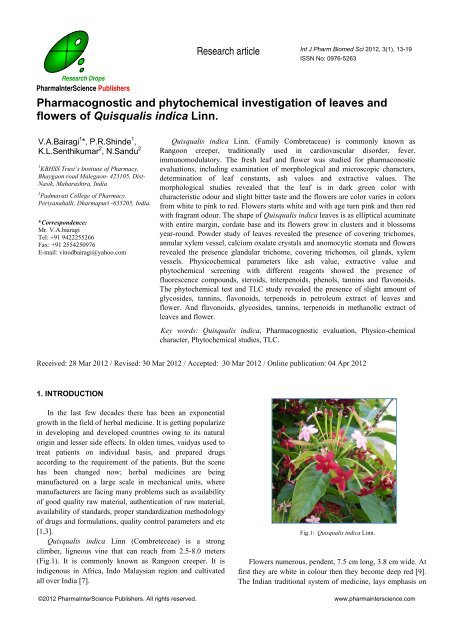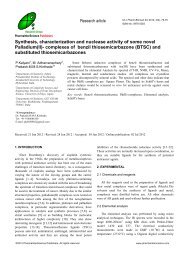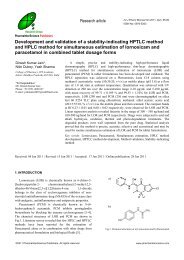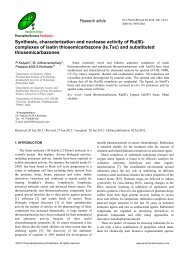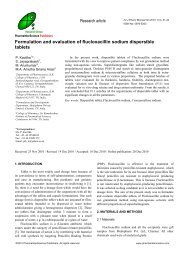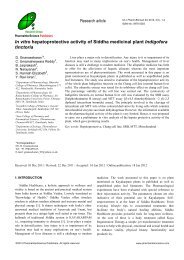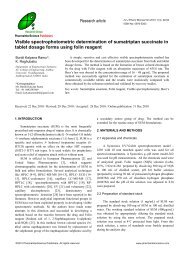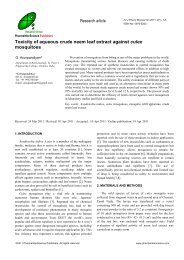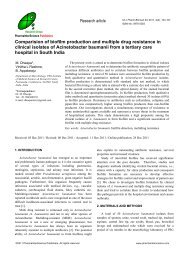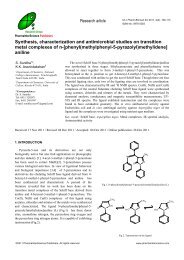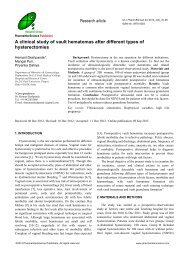Pharmacognostic and phytochemical investigation of leaves and ...
Pharmacognostic and phytochemical investigation of leaves and ...
Pharmacognostic and phytochemical investigation of leaves and ...
You also want an ePaper? Increase the reach of your titles
YUMPU automatically turns print PDFs into web optimized ePapers that Google loves.
Research article<br />
Int J Pharm Biomed Sci 2012, 3(1), 13-19<br />
ISSN No: 0976-5263<br />
Research Drops<br />
PharmaInterScience Publishers<br />
<strong>Pharmacognostic</strong> <strong>and</strong> <strong>phytochemical</strong> <strong>investigation</strong> <strong>of</strong> <strong>leaves</strong> <strong>and</strong><br />
flowers <strong>of</strong> Quisqualis indica Linn.<br />
V.A.Bairagi 1 *, P.R.Shinde 1 ,<br />
K.L.Senthikumar 2 , N.S<strong>and</strong>u 2<br />
1 KBHSS Trust’s Institute <strong>of</strong> Pharmacy,<br />
Bhaygaon road Malegaon- 423105, Dist-<br />
Nasik, Maharashtra, India<br />
2 Padmavati College <strong>of</strong> Pharmacy,<br />
Periyanahalli, Dharmapuri -635205, India.<br />
*Correspondence:<br />
Mr. V.A.bairagi<br />
Tel: +91 9422255266<br />
Fax: +91 2554250976<br />
E-mail: vinodbairagi@yahoo.com<br />
Quisqualis indica Linn. (Family Combretaceae) is commonly known as<br />
Rangoon creeper, traditionally used in cardiovascular disorder, fever,<br />
immunomodulatory. The fresh leaf <strong>and</strong> flower was studied for pharmaconostic<br />
evaluations, including examination <strong>of</strong> morphological <strong>and</strong> microscopic characters,<br />
determination <strong>of</strong> leaf constants, ash values <strong>and</strong> extractive values. The<br />
morphological studies revealed that the leaf is in dark green color with<br />
characteristic odour <strong>and</strong> slight bitter taste <strong>and</strong> the flowers are color varies in colors<br />
from white to pink to red. Flowers starts white <strong>and</strong> with age turn pink <strong>and</strong> then red<br />
with fragrant odour. The shape <strong>of</strong> Quisqualis indica <strong>leaves</strong> is as elliptical acuminate<br />
with entire margin, cordate base <strong>and</strong> its flowers grow in clusters <strong>and</strong> it blossoms<br />
year-round. Powder study <strong>of</strong> <strong>leaves</strong> revealed the presence <strong>of</strong> covering trichomes,<br />
annular xylem vessel, calcium oxalate crystals <strong>and</strong> anomocytic stomata <strong>and</strong> flowers<br />
revealed the presence gl<strong>and</strong>ular trichome, covering trichomes, oil gl<strong>and</strong>s, xylem<br />
vessels. Physicochemical parameters like ash value, extractive value <strong>and</strong><br />
<strong>phytochemical</strong> screening with different reagents showed the presence <strong>of</strong><br />
fluorescence compounds, steroids, triterpenoids, phenols, tannins <strong>and</strong> flavonoids.<br />
The <strong>phytochemical</strong> test <strong>and</strong> TLC study revealed the presence <strong>of</strong> slight amount <strong>of</strong><br />
glycosides, tannins, flavonoids, terpenoids in petroleum extract <strong>of</strong> <strong>leaves</strong> <strong>and</strong><br />
flower. And flavonoids, glycosides, tannins, terpenoids in methanolic extract <strong>of</strong><br />
<strong>leaves</strong> <strong>and</strong> flower.<br />
Key words: Quisqualis indica, <strong>Pharmacognostic</strong> evaluation, Physico-chemical<br />
character, Phytochemical studies, TLC.<br />
Received: 28 Mar 2012 / Revised: 30 Mar 2012 / Accepted: 30 Mar 2012 / Online publication: 04 Apr 2012<br />
1. INTRODUCTION<br />
In the last few decades there has been an exponential<br />
growth in the field <strong>of</strong> herbal medicine. It is getting popularize<br />
in developing <strong>and</strong> developed countries owing to its natural<br />
origin <strong>and</strong> lesser side effects. In olden times, vaidyas used to<br />
treat patients on individual basis, <strong>and</strong> prepared drugs<br />
according to the requirement <strong>of</strong> the patients. But the scene<br />
has been changed now; herbal medicines are being<br />
manufactured on a large scale in mechanical units, where<br />
manufacturers are facing many problems such as availability<br />
<strong>of</strong> good quality raw material, authentication <strong>of</strong> raw material,<br />
availability <strong>of</strong> st<strong>and</strong>ards, proper st<strong>and</strong>ardization methodology<br />
<strong>of</strong> drugs <strong>and</strong> formulations, quality control parameters <strong>and</strong> etc<br />
[1,3].<br />
Quisqualis indica Linn (Combreteceae) is a strong<br />
climber, ligneous vine that can reach from 2.5-8.0 meters<br />
(Fig.1). It is commonly known as Rangoon creeper. It is<br />
indigenous in Africa, Indo Malaysian region <strong>and</strong> cultivated<br />
all over India [7].<br />
Fig.1: Quisqualis indica Linn.<br />
Flowers numerous, pendent, 7.5 cm long, 3.8 cm wide. At<br />
first they are white in colour then they become deep red [9].<br />
The Indian traditional system <strong>of</strong> medicine, lays emphasis on<br />
©2012 PharmaInterScience Publishers. All rights reserved. www.pharmainterscience.com
V.A.bairagi et al, Int J Pharm Biomed Sci 2012, 3(1), 13-19<br />
14<br />
promotion <strong>of</strong> health promotive, disease preventive <strong>and</strong><br />
rejuvenation approach. The Indian traditional system <strong>of</strong><br />
medicine, lays emphasis on promotion <strong>of</strong> health promotive,<br />
disease preventive <strong>and</strong> rejuvenation approach. Oxidative<br />
stress plays a major part in the development <strong>of</strong> chronic <strong>and</strong><br />
degenerative ailments such as cancer, arthritis, aging,<br />
autoimmune disorders, cardiovascular <strong>and</strong> neurodegenerative<br />
diseases [11]. From the above literature, it is clear that no<br />
pharmacognostic work is carried out. The present study was<br />
therefore undertaken to investigate the pharmacognostic<br />
characters <strong>and</strong> <strong>phytochemical</strong> analysis <strong>of</strong> the plant.<br />
2. MATERIALS AND METHODS<br />
2.1 Plant material<br />
Fig.2. Transverse section <strong>of</strong> Quisqualis indica leaf<br />
The plant material was collected from the Malegaon city<br />
<strong>of</strong> Dist. Nasik, Maharashtra, in the month <strong>of</strong> September-<br />
2009 at the time <strong>of</strong> collection, plant including <strong>leaves</strong> <strong>and</strong><br />
flowers were collected. The plant was authenticated by Mr.<br />
Arvind S. Dhabe (Herbarium in charge), Assistant Pr<strong>of</strong>essor<br />
<strong>of</strong> Department <strong>of</strong> Botany. Dr. Babasaheb Ambedkar<br />
Marathwada University, Aurangabad, (M.S.) India. The<br />
<strong>leaves</strong> <strong>and</strong> flowers part were separated from other parts,<br />
washed, cleaned <strong>and</strong> dried for further use.<br />
2.2 <strong>Pharmacognostic</strong> studies<br />
2.2.1 Macroscopy<br />
Morphological studies were done by using simple<br />
microscope. The shape, apex, base, margin, taste <strong>and</strong> odor <strong>of</strong><br />
<strong>leaves</strong> <strong>and</strong> flowers were determined.<br />
2.2.2 Microscopy<br />
Microscopic studies were done by preparing a thin h<strong>and</strong><br />
section <strong>of</strong> midrib <strong>of</strong> <strong>leaves</strong> <strong>and</strong> pedicels <strong>of</strong> flower <strong>of</strong><br />
Quisqualis indica Linn. The section were cleared with chloral<br />
hydrate solution, stained with Phloroglucinol <strong>and</strong><br />
hydrochloric acid, <strong>and</strong> mounted with glycerin. A separate<br />
section were prepared <strong>and</strong> stained with iodine solution for the<br />
identification <strong>of</strong> starch grains. Transverse sections <strong>of</strong> the leaf<br />
<strong>and</strong> ovary with pedicel <strong>of</strong> Quisqualis indica are shown in<br />
Fig.2 <strong>and</strong> Fig.3, respectively.<br />
Powder <strong>of</strong> the dried <strong>leaves</strong> <strong>and</strong> flower were used for the<br />
observation <strong>of</strong> powder microscopical characters. The<br />
powdered drug was separately treated with phloroglucinol<br />
<strong>and</strong> HCl solution, glycerin <strong>and</strong> iodine solution to determine<br />
the presence <strong>of</strong> lignified cells, calcium oxalate crystals,<br />
trichomes <strong>and</strong> starch grains [8]. The results were registered<br />
by botanical illustration <strong>and</strong> photos taken by means <strong>of</strong> the<br />
Motic digital microscope (Motic instrument Inc, Canada)<br />
fitted with 1/3” CCD camera imaging accessory with motic<br />
image 2000 image analysis s<strong>of</strong>tware.<br />
Fig.3. Transverse section <strong>of</strong> ovary with pedicel <strong>of</strong> Quisqualis indica<br />
2.3 Micro chemical <strong>investigation</strong>/ Histochemistry<br />
Micro-chemical tests <strong>and</strong> testing <strong>of</strong> behaviour <strong>of</strong> specific<br />
reagent towards plant drug tissue was carried out. The plant<br />
drug tissue was subjected to various reagents <strong>and</strong> based upon<br />
the inference, the histological zones were estimated [6, 16].<br />
2.4 Quantitative microscopy<br />
As a part <strong>of</strong> quantitative microscopy, stomatal number,<br />
stomatal index, vein islet <strong>and</strong> vein termination number were<br />
determined by using fresh <strong>leaves</strong> <strong>of</strong> the plant [10].<br />
2.5 Physico-chemical constants<br />
Total ash, water soluble ash, acid insoluble ash <strong>and</strong><br />
sulphated ash were determined. Alcohol <strong>and</strong> water soluble<br />
extractive values were determined to find out the amount <strong>of</strong><br />
water <strong>and</strong> alcohol soluble components. [5, 13].<br />
2.6 Behavior <strong>of</strong> leaf powder with different chemicals<br />
Behavior <strong>of</strong> leaf powder with different chemical reagents<br />
was studied to detect the presence <strong>of</strong> phytoconstituents with<br />
color changes under daylight by reported method [15].<br />
©2012 PharmaInterScience Publishers. All rights reserved. www.pharmainterscience.com
V.A.bairagi et al, Int J Pharm Biomed Sci 2012, 3(1), 13-19<br />
15<br />
Table 1<br />
TLC pr<strong>of</strong>ile for petroleum ether <strong>and</strong> methanolic extract <strong>of</strong> Quisqualis indica<br />
Sl. No. Extract Mobile phase Detecting reagent<br />
1. PEL Pet. Ether : Ethyl acetate (8:2) Liebermann-burched reagent<br />
2. PEF Pet. Ether : Ethyl acetate (8:2) Liebermann-burched reagent<br />
3. MEL 1.Tolune: Ethyl acetate: formic acid (2.5:1:1)<br />
2. Ethyl acetate: Methanol : Water: Toluene (10:1.5:1.3:2)<br />
Methanolic FeCl 3<br />
Scan at UV 254& natural product reagent<br />
5. MEF 1.Tolune: Ethyl acetate: formic acid (2.5:1:1)<br />
2.Ethyl acetate: Methanol: Water: Toluene (10:1.5:1.3:2)<br />
Methanolic FeCl 3<br />
Scan at UV 254 & natural product reagent<br />
PEL: Petroleum ether extract <strong>of</strong> <strong>leaves</strong>, PEF: Petroleum extract <strong>of</strong> flower, MEL: methanolic extract <strong>of</strong> <strong>leaves</strong>, MEF: methanolic extract <strong>of</strong> flower.<br />
Table 2<br />
Histochemical color reactions <strong>of</strong> Quisqualis indica leaf <strong>and</strong> flower powder<br />
Reagents Constituents Colors Histological zones<br />
Aniline SO 4 + H 2 SO 4 Lignin Yellow Xylem<br />
Phloroglucinol + HCl Lignin Pink Xylem, Sclerenchyma<br />
Conc. H 2 SO 4 Cellulose Green Mesophyll<br />
Weak Iodine solution Starch -- --<br />
Millon’s reagent Proteins White Spongy parenchyma<br />
H 2 SO 4 Ca. Oxalate Needles<br />
Mesophyll, <strong>and</strong> midrib<br />
SbCl 3<br />
Steroids/<br />
Triterpenoids<br />
/prismatic<br />
Reddish pink<br />
parenchyma<br />
Mesophyll<br />
2.7 Successive solvent extraction<br />
The plant material <strong>leaves</strong> <strong>and</strong> flowers were air-dried at<br />
room temperature for 10 days <strong>and</strong> pulverized by grinder.<br />
Powdered <strong>of</strong> dried <strong>leaves</strong> <strong>and</strong> flowers <strong>of</strong> Quisqualis indica<br />
Linn (200 g) was successively extracted with petroleum ether<br />
(60-800) using a soxhlet apparatus. The extracts were<br />
concentrated <strong>and</strong> greenish yellow semisolid mass (coded<br />
“PEL <strong>and</strong> PEF”) were obtained. The resulting marc were<br />
exhaustively extracted by same method using methanol <strong>and</strong><br />
greenish brown mass (coded “MEL <strong>and</strong> MEF”) were<br />
obtained after concentration on a water bath The extracts<br />
were stored aseptically in a desiccators at room temperature<br />
until dem<strong>and</strong>ed [14].<br />
2.8 Phytochemical Screening<br />
The crude petroleum ether extract <strong>and</strong> methanol extracts<br />
were screened <strong>phytochemical</strong>ly for the presence <strong>of</strong> its<br />
constituents utilizing st<strong>and</strong>ard methods <strong>of</strong> analyses [2, 4, 17].<br />
2.9 Thin layer chromatography<br />
For the TLC fingerprint the petroleum ether extract <strong>and</strong><br />
methanolic extract were subjected to thin layer<br />
chromatographic analysis, to find the presence <strong>of</strong> number <strong>of</strong><br />
chemical constituents to support the chemical test (Table 1).<br />
Analytical TLC plates were prepared by pouring the silica gel<br />
G slurry on the glass plates. Drying the thin layer plates, for<br />
30 min in air <strong>and</strong> then in an oven at 110°C for another 30<br />
min. For qualitative work, spot was applied in a row along<br />
one side <strong>of</strong> plate, about 2 cm from edge, by using capillary<br />
tubes. The range <strong>of</strong> sample volume was controlled, spreading<br />
not more than 0.5 cm. The plate was placed in previously<br />
saturated TLC chamber with mobile phase. The R f values<br />
were compared with st<strong>and</strong>ard drug <strong>and</strong> colours were recorded<br />
[12,18].<br />
3. RESULTS<br />
3.1 Morphological study<br />
Quisqualis indica Linn is evergreen (in the tropics) <strong>and</strong><br />
rambunctious vine, free branching <strong>and</strong> vigorous-growing,<br />
needing sturdy support. Macroscopically, the leaf is simple in<br />
composition, opposite in arrangement, apex <strong>and</strong> base are<br />
acuminate & cordate, margin is entire, venation is parallel,<br />
shape oblong- lanceolate <strong>and</strong> average leaf size is 6.8 cm ± 0.9<br />
(length) <strong>and</strong> 3.4 cm ± 0.2 (breadth). Fresh <strong>leaves</strong> are pale<br />
green in colour, odourless <strong>and</strong> tastless. Surface <strong>of</strong> leaf are<br />
silky <strong>and</strong> smooth. The midrib is prominent on lower surface.<br />
The flowers are raceme type arrangement; texture is very<br />
smooth & silky. The flowers are fragrant <strong>and</strong> tubular <strong>and</strong><br />
their color varies from white to pink to red average size <strong>of</strong><br />
flower about 30-35 cm long. Odour is aromatic, taste is<br />
aromatic & sweet. Flowers starts white <strong>and</strong> with age turn<br />
pink <strong>and</strong> then red. Its flowers grow in clusters <strong>and</strong> it<br />
blossoms year-round. Its flowers open at night with five<br />
bright red petals <strong>and</strong> gives out a distinct perfume (Fig.1).<br />
3.2 Micro chemical <strong>investigation</strong>/ Histochemistry<br />
Observation <strong>and</strong> result pertaining to microchemical tests<br />
<strong>and</strong> behavior <strong>of</strong> specific reagent towards plant tissue were<br />
©2012 PharmaInterScience Publishers. All rights reserved. www.pharmainterscience.com
V.A.bairagi et al, Int J Pharm Biomed Sci 2012, 3(1), 13-19<br />
16<br />
a. Parenchymatous tissue b. Unicellular trichome c. Calcium oxalate<br />
d. Anomocytic stomata e. Xylem vessels f. Gl<strong>and</strong>ular trichome<br />
g. Epidermis h. Oil gl<strong>and</strong>s (in flower) i. Spiral vessels (in flower)<br />
Fig.4 (a-i): Showing various characteristic features <strong>of</strong> flower <strong>and</strong> <strong>leaves</strong> <strong>of</strong> Quisqualis indica<br />
represented in Table 2. In the histochemical analysis the<br />
micro chemical tests showed the presence <strong>of</strong> midrib, vascular<br />
bundle <strong>and</strong> xylem vessels.<br />
3.3 Powder analysis<br />
The powder microscopy shows the fragments <strong>of</strong><br />
unicellular covering <strong>and</strong> gl<strong>and</strong>ular trichomes, phloem fibers,<br />
parenchyma cells, numerous xylem vessels <strong>of</strong> spiral type <strong>and</strong><br />
Epidermal cells with anomocytic stomata is shown in Fig.4.<br />
3.4 Quantitative microscopy<br />
As a part <strong>of</strong> quantitative microscopy, stomatal number,<br />
stomatal index, vein islet <strong>and</strong> vein termination number were<br />
determined by using fresh <strong>leaves</strong> <strong>of</strong> the plant (Table 3).<br />
Table 3<br />
Data representing values <strong>of</strong> quantitative microscopical studies <strong>of</strong> leaf<br />
Parameter<br />
Values<br />
Stomatal number 0.28-0.32<br />
Stomatal index 15.12-20.32<br />
Vein islet no. 2-5<br />
Vein termination no. 3-6<br />
Phloem fiber<br />
Length:6.76-78.21<br />
Width :1.06-1.45<br />
Calcium oxalate crystals<br />
Length:1.6-3.2<br />
Width :1.2-1.6<br />
Starch grains 1.56-8.0<br />
Trichomes:<br />
3.5 Physical constant<br />
Length:10.62-45.54<br />
Width :1.56-2.56<br />
The physical constant evaluation <strong>of</strong> the drugs is an<br />
important parameter in detecting adulteration or improper<br />
h<strong>and</strong>ling <strong>of</strong> drugs. The total ash is particularly important in<br />
©2012 PharmaInterScience Publishers. All rights reserved. www.pharmainterscience.com
V.A.bairagi et al, Int J Pharm Biomed Sci 2012, 3(1), 13-19<br />
17<br />
the evaluation <strong>of</strong> purity <strong>of</strong> drugs, i.e. the ash values,<br />
extractive values <strong>and</strong> moisture content <strong>of</strong> <strong>leaves</strong> <strong>and</strong> flowers<br />
were determined. The results are depicted in Table 4.<br />
Table 4<br />
Data representing physiological parameter<br />
Sl. No. Parameters % w/w (leaf) %w/w (flowers)<br />
1 Ash value<br />
Total ash<br />
Acid insoluble<br />
Water soluble<br />
Sulphated ash<br />
2 Extractive values<br />
Water soluble<br />
Alcohol soluble<br />
7<br />
1.5<br />
3.5<br />
5.67<br />
5<br />
1<br />
3<br />
3.45<br />
18<br />
11<br />
14.12 9.1<br />
3 Moisture content (LOD) 12 10<br />
Table 5<br />
Behavior <strong>of</strong> Ficus hispida leaf powder with different chemical reagents<br />
Regents Color/ppt Constituents<br />
Picric acid Slight ppt. Alkaloids present<br />
Conc. H 2 SO 4 Reddish brown Steroids/triterpenoids<br />
present<br />
Aq. FeCl 3 Bluish black ppt Tannins present<br />
Iodine solution No change Starch absent<br />
Ammonia No change Anthroquinone<br />
glycosides absent<br />
Spot test Stains observed Fixed oils present<br />
Aq. AgNO 3 Precipitation Proteins present<br />
Aq. NaOH Yellow Flavonoids present<br />
Mg – Hcl Magenta Flavonoids present<br />
Aq. Lead acetate White ppt Tannins present<br />
Liberman Burckhardt’s<br />
test<br />
Reddish green<br />
Steroids <strong>and</strong> tannins are<br />
present<br />
Table 6<br />
Phytochemical screening <strong>of</strong> Quisqualis indica linn. extracts<br />
Sl. No. Chemical test PEL PEF MEL MEF<br />
1 Alkaloids<br />
i.Dragendorff’s<br />
ii.Wagners<br />
2 Amino acids <strong>and</strong> proteins<br />
Xanthoproetic test + + ++ ++<br />
3 Carbohydrates<br />
Molish test + + ++ ++<br />
4 Flavonoids<br />
i. Shinoda test<br />
ii. Lead acetate test<br />
5 Glycoside<br />
i. Legal test<br />
ii. Baljet tet<br />
6 Tannins<br />
i. Lead acetate test<br />
ii. Ferric chloride test<br />
++<br />
+<br />
-<br />
+<br />
-<br />
+<br />
7 Phytosterol<br />
i. Salkowski test<br />
++<br />
ii.Liebermann’s Burchard reaction ++<br />
-<br />
-<br />
++<br />
-<br />
-<br />
+<br />
-<br />
+<br />
-<br />
-<br />
++<br />
++<br />
Key: ++ = Highly present, + = faintly present, - = absent.<br />
3.6 Phytochemical <strong>investigation</strong><br />
-<br />
+<br />
++<br />
++<br />
-<br />
++<br />
++<br />
++<br />
-<br />
-<br />
-<br />
+<br />
++<br />
++<br />
-<br />
++<br />
++<br />
++<br />
Successive extraction <strong>of</strong> the leaf <strong>and</strong> flower powder was<br />
carried out <strong>and</strong> methanolic extracts were found to give a<br />
maximum extractive yield. In the <strong>phytochemical</strong> tests the<br />
-<br />
-<br />
pet.ether extract revealed the presence <strong>of</strong> terpenoids, steroid,<br />
alkaloids, amino acids, <strong>and</strong> glycoside (for instance Table 5).<br />
Methanolic extract revealed presence <strong>of</strong> carbohydrates,<br />
flavonoids, vitamins, amino acids, proteins, tannins,<br />
glycosides <strong>and</strong> steroids. Preliminary <strong>phytochemical</strong> results <strong>of</strong><br />
individual’s tests for various phytoconstituents are stated in<br />
Table 6.<br />
3.7 Thin layer chromatography<br />
The separation <strong>and</strong> purification <strong>of</strong> phytoconstituents <strong>of</strong><br />
extract were mainly carried out using a combination <strong>of</strong><br />
chromatographic techniques. The choice <strong>of</strong> techniques<br />
depends upon the solubility properties <strong>and</strong> volatilities <strong>of</strong><br />
compound to be separated. Thin layer chromatography is a<br />
method <strong>of</strong> choice for separating all lipid soluble components,<br />
i.e. the lipids, steroids, carotenoids, flavonoids, glycosides,<br />
tannins, simple quinines <strong>and</strong> chlorophyll. TLC <strong>of</strong> PEL, PEF,<br />
MEL <strong>and</strong> MEF extracts resulted in Table 7 <strong>and</strong> Fig.5.<br />
4. DISCUSSION<br />
Microscopic analysis <strong>and</strong> qualitative parameters are<br />
carried out on plant samples in order to establish appropriate<br />
data that can be used in identifying crude drugs particularly<br />
those supplied in powder form. Powder study <strong>of</strong> <strong>leaves</strong><br />
revealed the presence <strong>of</strong> covering trichomes, annular xylem<br />
vessel, calcium oxalate crystals <strong>and</strong> anomocytic stomata <strong>and</strong><br />
flowers revealed the presence gl<strong>and</strong>ular trichome, covering<br />
trichomes, oil gl<strong>and</strong>s, xylem vessels. The Moisture content,<br />
Total ash, acid insoluble ash, water-soluble ash values <strong>and</strong><br />
sulfated ash <strong>of</strong> <strong>leaves</strong> were observed to be 8%, 9%, 12.5%,<br />
6.55% <strong>and</strong> 5.45% w/w respectively <strong>and</strong> flowers were 10%,<br />
5%, 1%, 3% <strong>and</strong> 3.5% respectively. Water-soluble extractive<br />
values, alcohol soluble extractive value <strong>and</strong> petroleum ether<br />
soluble extractive value <strong>of</strong> the <strong>leaves</strong> were observed to<br />
be18%, 11% <strong>and</strong> 20% w/w, respectively <strong>and</strong> flower were<br />
11%, 9.1% <strong>and</strong> 12%, respectively. They are st<strong>and</strong>ard<br />
pharmacognostic parameters that can be used to differentiate<br />
closely related plant species or varieties with similar<br />
constituents or pharmacological activities. The behavior <strong>of</strong><br />
the powder upon treatment with different chemical reagents<br />
was also observed <strong>and</strong> reported. Fluorescence studies <strong>of</strong><br />
powder with various reagents revealed the presence <strong>of</strong> green<br />
fluorescence with conc. HCl <strong>and</strong> sodium hydroxide, under<br />
UV light. The various qualitative chemical tests <strong>of</strong> petroleum<br />
ether <strong>and</strong> methanol extract indicates the presence <strong>of</strong> sterols,<br />
triterpenoids, flavonoids, phenols <strong>and</strong> tannins in large<br />
amounts whereas aromatic acids, gums, mucilage were<br />
totally absent in the leaf <strong>and</strong> flower extract <strong>of</strong> this plant.<br />
Phytoconstituents <strong>of</strong> the <strong>leaves</strong> <strong>and</strong> flower have potential <strong>of</strong><br />
organic acids, phytosterols, terpenoids, flavonoids, phenolic<br />
compounds, tannins <strong>and</strong> reducing sugars which has to found<br />
possesses antioxidant, mast cells stabilizing, can act against<br />
allergies, ulcers, tumors, platelet aggregation, <strong>and</strong> controlling<br />
hypertension <strong>and</strong> immunomodulatory effects. The<br />
©2012 PharmaInterScience Publishers. All rights reserved. www.pharmainterscience.com
V.A.bairagi et al, Int J Pharm Biomed Sci 2012, 3(1), 13-19<br />
18<br />
Table 7<br />
TLC pattern <strong>of</strong> different extract <strong>of</strong> <strong>leaves</strong> <strong>and</strong> flower<br />
Sl .No. Extract No. <strong>of</strong> spot &Color after spraying Rf value<br />
1. PEL 9 spot( blue, yellow, pink, pink, violet, violet, grey, blue, violet) 0.19, 0.3, 0.33, 0.37, 0.43, 0.61, 0.72, 0.89, 0.92 respectively.<br />
2. PEF 8 spots(brown, orange, pink, red, violet, grey, pink, blue) 0.64, 0.54,0.45 respectively<br />
3. MEL 1. solvent system :3 spots (deep blue)<br />
2. solvent system: 9 spot (yellowish orange colour)<br />
1.0.25, 0.32, 0.39 respectively<br />
2.0.25,0.31,0.35,0.37,0.4,0.55,0.7,0.81,0.92, respectively<br />
4. MEF 1. mobile phase: 5 spots ( deep blue)<br />
2. solvent system: 10spot(yellowish orange colour)<br />
1. 0.25, 0.32, 0.39 respectively<br />
2.0.25,0.31,0.35,0.37,0.4,0.55,0.7,0.81,0.92, 0.97 respectively<br />
A B C D<br />
Fig.5. Thin layer chromatography <strong>of</strong><br />
(A) PEL & PEF extracts after derivatization with Libermann burched reagent<br />
(B) MEL& MEF extract after derivatization with ethanolic FeCl 3.<br />
(C) MEL & MEF extract after derivatization with Natural product reagent<br />
(D) MEL& MEF extract at 254 nm<br />
constituents <strong>of</strong> this plant have tremendous impact on the<br />
health care system <strong>and</strong> may provide medical health benefits<br />
including the prevention <strong>and</strong> or treatment <strong>of</strong> diseases.<br />
5. CONCLUSION<br />
Since the plant, Quisqualis indica which is also used for<br />
the treatment <strong>of</strong> various diseases <strong>and</strong> disorders, it is important<br />
to st<strong>and</strong>ardize it for use as a drug. The pharmacognostic<br />
constants for the <strong>leaves</strong> <strong>and</strong> flowers <strong>of</strong> this plant, the<br />
diagnostic microscopic features <strong>and</strong> the numerical st<strong>and</strong>ards<br />
reported in this work could be useful for the compilation <strong>of</strong> a<br />
suitable monograph for its proper identification.<br />
6. ACKNOWLEDGEMENT<br />
Authors are heartily thankful to Chairman, Mr. Baliramji<br />
Hiray <strong>and</strong> Chief Mentor, Mr. Prasad Hiray for providing<br />
necessary facilities at Institute <strong>of</strong> Pharmacy, <strong>and</strong> also thanks<br />
Mr. Arvind S. Dhabe (Herbarium in charge), Assistant<br />
pr<strong>of</strong>essor <strong>of</strong> Department <strong>of</strong> botany. Dr. Babasaheb Ambedkar<br />
Marathwada University, Aurangabad for identification <strong>of</strong> the<br />
plant.<br />
REFERENCES<br />
[1] Agrawal OP. Advanced practical organic Chemistry. Goel Publishing<br />
House, Meerut, 2000.<br />
[2] Agrawal A. Critical issues in quality control <strong>of</strong> herbal products. Pharm<br />
Times 2005, 37, 09-11.<br />
[3] Ali MS, Ahmed F, Pervez MK, Azhar I, Ibrahim SA, Parkintin A. A<br />
new flavanone with epoxyisopentyl moiety from Parkinsonia aculeate<br />
Lin. Nat Prod Res 2005, 19, 53-60.<br />
[4] Finar IL. Organic chemistry: Stereo Chemistry & the chemistry <strong>of</strong><br />
Natural products. Longman group Ltd. 1975, pp. 176.<br />
[5] Indian Pharmacopoeia. Ministry <strong>of</strong> health <strong>and</strong> family welfare Govt. <strong>of</strong><br />
India, Controller <strong>of</strong> publication, New Delhi 1996, pp. 310.<br />
[6] Johansen D. Plant microtechnique. McGraw-Hill, New York. 1940, pp.<br />
126-154.<br />
[7] Joshi SG. Medicinal plants. Primlani M. Oxford <strong>and</strong> IBH publishing<br />
Co.pvt. Ltd, New Delhi 2002, pp. 141.<br />
©2012 PharmaInterScience Publishers. All rights reserved. www.pharmainterscience.com
V.A.bairagi et al, Int J Pharm Biomed Sci 2012, 3(1), 13-19<br />
[8] Kh<strong>and</strong>elwal KR. Practical Pharmacognosy, Techniques <strong>and</strong><br />
Experimental. Nirali Prakashan, New Delhi 2003, pp.149-153.<br />
[9] Kirtikar KR, Basu BD. Indian Medicinal plant. Valley <strong>of</strong>fset publishers,<br />
New delhi 2006, pp. 1037.<br />
[10] Kokate CK. Practical Pharmacognosy. Vallabh Prakashan, New Delhi<br />
1994, pp. 112-121.<br />
[11] Lien A, Pham H, Hua H, Chuong PH. Free Radicals, Antioxidants in<br />
Disease <strong>and</strong> Health. Int J Biomed Sci 2008, 4, 89-96.<br />
[12] Mendham J, Denney RC, Thomas MJ. Vogel’s Textbook <strong>of</strong> Qualitative<br />
Chemical Analysis. Pearson Education Pvt. Ltd 2002, pp. 256-257.<br />
[13] Mohammed Ali. Text book <strong>of</strong> Pharmacognosy. CBS publishers <strong>and</strong><br />
Distributors, New Delhi 1994, pp. 81,116,372,447.<br />
[14] Mukherjee PK. Quality Control <strong>of</strong> Herbal Drugs. Business Horizons,<br />
New Delhi 2002. pp. 67-92.<br />
[15] Pratt RT, Chase ER. Fluorescence powder vegetable drugs in particular<br />
to development system <strong>of</strong> identification. J Am Pharm Assoc 1949, 38,<br />
324331.<br />
[16] Singh VK. Govil J. Ethnomedicine <strong>and</strong> Pharmacognosy. Vol. I. Sci<br />
Tech Publishing Inc, USA 2002. pp. 337-342.<br />
[17] Trease GE. Evans WC. Pharmacognosy. Saunders Publishers, London<br />
2002.<br />
[18] Wagner H, Bladt S. Plant Drug Analysis. A Thin Layer<br />
Chromatography. Springer 1996, pp.196-200.<br />
19<br />
©2012 PharmaInterScience Publishers. All rights reserved. www.pharmainterscience.com


